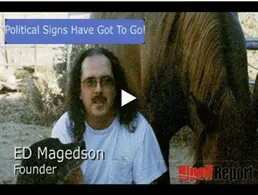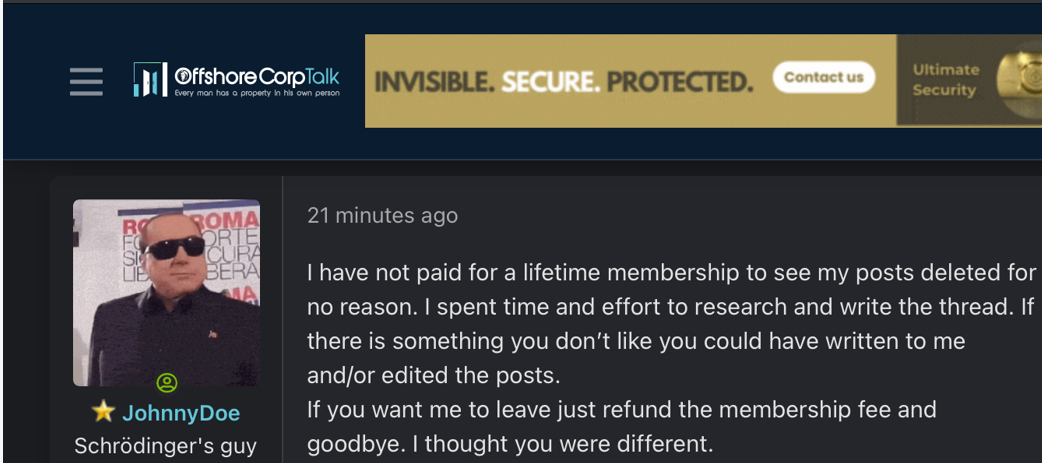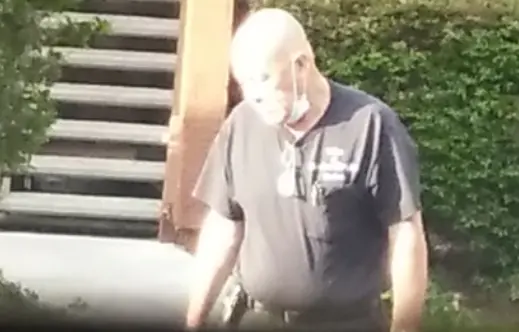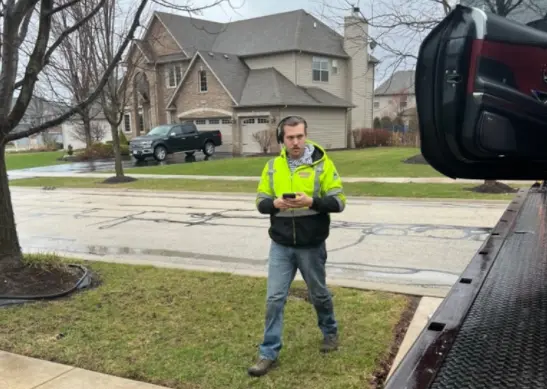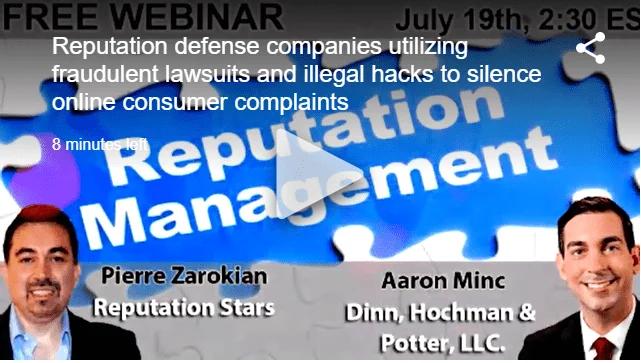Complaint Review: DAVID ROSS CALVERT - GREENWOOD VILLAGE Colorado
- DAVID ROSS CALVERT 5460 S. Quebec St Greenwood Village, CO 80111 GREENWOOD VILLAGE, Colorado United States of America
- Phone: 3037407900
- Web: CALVERTLEGAL.COM
- Category: Lawyers
DAVID ROSS CALVERT DAVID CALVERT, ESQ. DAVID CALVERT LAW FIRM COLORADO SUPREME COURT DISBARS DAVID ROSS CALVERT GREENWOOD VILLAGE, Colorado
listed on other sites?
Those sites steal
Ripoff Report's
content.
We can get those
removed for you!
Find out more here.
Ripoff Report
willing to make a
commitment to
customer satisfaction
Click here now..
SUPREME COURT, STATE OF COLORADO ORIGINAL PROCEEDING IN DISCIPLINE BEFORE . THE OFFICE OF THE PRESIDING DISCIPLINARY JUDGE 1560 BROADWAY, SUITE 675 DENVER, CO 80202 Complainant: Case Number: THE PEOPLE OF THE STATE OF COLORADO 09PDJ064 (consolidated Respondent: with 10PDJ 128) DAVID ROSS CALVERT AMENDED OPINION AND DECISION IMPOSING SAN CTIONS PURSUANT TO C.R.C.P. 251.19[b) From July 6 through 8, 2011, a Hearing Board composed of Marilyn L. Robertson, a member of the bar, Melinda M. Harper, CPA/ABV, CFE, a citizen member, and William R. Lucero, the Presiding Disciplinary Judge ("the PDJ"], held a C.R.C.P. 251.18 hearing. Margaret B. Funk appeared on behalf of the Office of Attorney Regulation Counsel ("the People"), and David Ross Calvert ("Respondent") appeared, represented by his counsel, Richard C. Casey. The Hearing Board now issues the following 'Amended Opinion and Decision Imposing Sanctions Pursuant to C.R.C.P. 25l.19[b)."1 . I. SUMMARY In this consolidated action, the Hearing Board concludes Respondents many self-serving acts of misconduct represent an acute breach of client trust warranting disbarment. In one case, Respondent plied a vulnerable client with loans in excess of one hundred thousand dollars without memorializing the terms of those loans. To secure his interest in those loan funds, he recorded a false deed of trust on the client's home in a second clients naine without the clients knowledge or consent. Respondent then attempted to persuade the second client to assign the deed of tnist to Respondents real estate company which, when taken together with his earlier acts, signals a calculated scheme to deprive his client of her home. In another case, he failed to supervise a non- lawyer while she provided direct legal services to two of his law firms clients, resulting in the dismissal of the clients bankruptcy petitions filed by the I This amended opinion redacts certain personal financial information of Stanislav and Linda Weinhauer, as requested in the People's "Notice of Request to Amend Judgment" filed on November 14, 2011. This nunc pro tune order is dated October 5, 2011. paralegal under Respondents name using his federal bankruptcy court
electronic log-in and password.
H. PROCEDURAL HISTORY
The People filed a complaint in case number 09PDJ064 on June 26,
2009. Following an extension of time to answer, Respondent filed an answer
on October 13, 2009. A hearing ir1 the case was set to begin April 6, 2010, but
was rescheduled for January 4, 2011, when Respondent experienced
significant health issues. By order of November 29, 2010, the hearing was
again rescheduled to May 3, 201 1, due to concerns about Respondent's health.
On December 9, 2010, the People filed a complaint in case number
10PDJ 128. Respondent answered on January 14, 2011. The People then filed
a motion to consolidate the two cases, which the PDJ granted on April 25,
2011, vacating the May 3, 2011, setting and scheduling the hearing ir1 the
consolidated action to begin on July 6, 201 1. Immediately prior to the hearing,
the PDJ declined to again continue the proceeding based on Respondents
concern that his prescribed medication might have "mind-a1tering" effects. The
PDJ observed Respondent appeared cogent and articulate, evincing no problem
recalling events or understanding questions, and the PDJ thus determined
there was no reason why Respondent would be unable to participate
meaningfully in the hearing.
At the hearing, the Hearing Board heard testimony from Linda
Weinhauer, Stanislav Weinhauer, Cindy WeinhauerHowe, Diane Mayberry,
Desi.ree Mayberry, Stephen Peters, Kelly Sweeny, Jeanne J agow, Erdal Sonmez,
Afthimia Sonmez, James Reitz, Yetty Yhin, Michelle Rahn, and Respondent.
The PDJ admitted the parties stipulated exhibits 1 99 and the Peoples
exhibits 101-102.
At the conclusion of the hearing, the PDJ instructed both parties to file
written closing arguments, which were submitted on August 1, 2011.
Respondent filed an amended closing argument on August 23, 2011, with no
objection from the People.
III. FINDINGS OF FACT AND RULE VIOLATIONS
The Hearing Board finds the following facts and rule violations have been
established by clear and convincing evidence.
Jurisdiction
Respondent took the oath of admission and was admitted to the bar of
the Colorado Supreme Court on April 13, 1962. He is registered upon the
official records, attorney registration number 01828, and is thus subject to the
jurisdiction of the Hearing Board in these disciplinary proceedings.2
Respondents registered business address is 5460 South Quebec Street, Suite
388, Greenwood Village, Colorado 801 ll.
Weinhauer Matters
In April 2008, Stanislav (Stanley) Weinhauer ("Mr. Weinhauer"), a.n
immigrant from the former communist state of Czechoslovakia, hired
Respondent to represent him. Mr. Weinhauer sought to reach a final
settlement with his former employer, King Soopers, in a workers compensation
matter, having been injured on the job in 1993 and placed on disability. Mr.
Weinhauer had been represented by several prior attorneys, but he sought
Respondents assistance when he was referred by Jana Kantor ("Kantor"), a
Weinhauer family friend and a pro bono client of Respondent. Respondent and
Mr. Wei.r1hauer executed a fee agreement on July 18, 2008, which provided
Respondent would be paid twenty percent of Mr. Weinhauers gross recovery.
On February 17, 2009, Respondent met with Mr. Weinhauer and his
wife, Linda Weinhauer (Mrs. Weinhauer"), to discuss a settlement proposal.
One of Respondents staff members memorialized the comprehensive
settlement package in a written memorandum: King Soopers would pay an
agreed amount, plus additional funds for a Medicare set-aside (which could
only be accessed by Mr. Weinhauer to pay future medical expenses related to
his workers compensation irqury], and Respondent would reduce his fee to ten
percent of the gross recovery.
Although the Weinhauers were hesitant to do so, they eventually agreed
to settle the case, and they visited Respondents office to sign the settlement
agreement on February 27, 2009. During this meeting, they requested that
Respondent review the settlement paperwork with them and explain how the
Medicare setaside would be funded. They also expressed concern about
outstanding medical bills, but Respondent assured them he would handle
payment of all such bills. Relying on these representations, Mr. Weinhauer
executed the settlement agreement and received all of the settlement funds due
him. During the spring of 2009, Respondent wrote letters on the Weinhauers
behalf to resolve these billing issues with the Division of Workers
Compensation, but he was not successful in doing so.5 As a result, the
Weinhauers began to receive calls around that time from collection agencies
2 See C.R.C.P. 251.l(b].
3 The People brought claims related to the Weinhauer matter in case number 10PDJ 128.
4 Ex. 3.
5 Exs. 11 12.
seeking payment of four unpaid medical bills. Because they understood from
Respondents assurances that he would handle these outstanding medical
bills, the Weinhauers called Respondent, with assistance from their daughter,
Cindy Weinhauer-Howe ("WeinhauerHowe"), to voice their concerns and urge
him to take action. Weinhauer-Howe and Respondent offered divergent
versions of this discussion; Weinhauer-Howe testified that Respondent
promised to "take care" of the bills and then hung up on her, while Respondent
claimed she "excoriated" him for his failure to resolve the payment issues.
Nevertheless, both agreed that the call concluded with Respondent
volunteering to pay these bills out of his own pocket.
On July 23, 2009, Respondent drafted letters to the health care providers
whom Mr. Weinhauer still owed for medical treatment, enclosing with each
letter a check "as an offer of settlement to conclude th[e] matter to closure."6
Respondent sent Mr. Weinhauer copies of these letters and copies of the front
of the four checks7 to demonstrate they had been paid, promising him the
matter had been resolved. Despite these assurances, however, Respondent
placed stop payment orders on two of the checks without notifying Mr.
Weinhauer, leaving those bills unpaid. Indeed, Mr. Weinhauer only discovered
these bills remained outstanding when collection agencies contacted him to
seek payment.
The People argue Respondents failure to notify Mr. Weinhauer that he
never paid these two medical bills constitutes a violation of Colo.
RPC l.4(a)(2) and (3) and Colo. RPC 8.4[c). They argue that Respondent failed
to comply with his duty, pursuant to Colo. RPC l.4(a)(2) and (3), to reasonably
consult with Mr. Weinhauer about the means by which his objectives were to
be accomplished and to keep Mr. Weinhauer reasonably infonned about the
status of his matter. And they contend Respondent misled Mr. Weinhauer, in
contravention of Colo. RPC 8.4(c), by promising to pay his medical bills, then
failing to inform him that two bills remained unpaid following issuance of the
stop payment orders.
Respondent argues his conduct amounts to nothing more than excusable
neglect. He testified his secretary inadvertently wrote all four checks from his
COLTAF account; when he realized the error, he placed stop payment orders on
two of them, restoring funds to his trust account for the two cleared checks.8
While Respondent admitted he never reissued the checks or notified Mr.
Weinhauer that the two bills remained unpaid, he maintains that "this was
because of an oversight on [his] part, not a willful action to harm [Mr.
Weinhauer] in any way."9 Respondent also contends his failure to reissue
6 Ex. 13.
7 Ex. 18.
8 Ex. 21. Respondent never clarified why he placed stop payment orders on just two of the four
checks, which all were drafted from his COLTAF account.
9 Respondents Tr. Br. at 2; see also Respondents Am. Closing Arg. at 5.
payment was an ancillary issue, and payment of those bills was not properly
considered among Mr. Weinhauers "objectives" of the representation.
The Hearing Board concludes Respondent violated Colo. RPC 8.4(c).
While Respondent argues in his written briefs that he simply forgot to noti
Mr. Weinhauer of the stop payment order, his statements on the stand belie
this contention. Indeed, he testified that upon issuing the stop payment order,
he "realized [he] had no obligation to take care of [the bills]" and therefore
declined to reissue payment. That Respondent guaranteed Mr. Weinhauer the
bills had been paid before, rather than after, the stop payment order was
placed is of no moment: by his own admission, Respondent knew Mr.
Weinhauer had relied upon his representations that the bills had been paid,
and he made no effort to correct Mr. Weinhauers misapprehensions after
placing the stop payment order. By failing to inform Mr. Weinhauer that he no
longer intended to honor his promise, Respondent misrepresented to Mr.
Weinhauer that all four medical bills had been paid, thereby violating Colo.
RPC 8.4(c).
Respondent also violated Colo. RPC l.4(a)(2) and (3), since he failed to
keep Mr. Weinhauer reasonably informed about the resolution of his medical
bills and the means by which Mr. Weinhauers objectives would have to be
accomplished. As an initial matter, we disagree with Respondents
characterization of this matter as peripheral. The Weir1hauers testimony, as
well as that of WeinhauerHowe, leads us to believe that this issue was critical
to Mr. Weinhauer, such that Respondents February 2009 promise to take
care" of the outstanding bills was a significant inducement to Mr. Weinhauer to
accept the settlement.
We also find unavailing Respondents attempt to disclaim his obligation
to communicate with Mr. Weinhauer concerning this matter. Comment 3 to
Colo. RPC 1.4 explains that even in the most exigent of circumstances a lawyer
"must nonetheless act reasonably to inform the client of actions the lawyer has
taken on the clients behalf." And comments 5 and 7 to the rule shed light on
that duty to communicate; comment 5 notes that a lawyer "should fulfill
reasonable client expectations for information consistent with the duty to act in
the clients best interest," while comment 7 counsels against the "withhold[ing
oi] information to serve the lawyers own interest or convenience .... " After
receiving copies of the four checks, Mr. Weinhauer reasonably expected
Respondent to alert him to any change in circumstance, and Respondents
awareness t.hat Mr. Weinhauer had relied on his promises obliged him to notify
Mr. Weinhauer about the stop payment order, even if doing so would have
caused the Weinhauers to react in a manner he deemed unpleasant or
inconvenient.
Business Transactions with Mayberry and the Weinhauersm
Diane Mayberry ("Mayberry") first met Respondent following the death of
her husband, Earl. Mayberry was listed as the primary beneficiary on her
husbands insurance policy, and she had come into a considerable sum of
money when he passed away. She chose to apply a significant portion of those
funds toward paying off the mortgage on her home, only after which she
realized her name was not listed on the title.
Mayberry hired Respondent to secure title to the house in her name,
which he did successfully,11 despite the efforts of Mayberrys children to
prevent him from doing so because, as Mayberry candidly acknowledgedand
as Desiree Mayberry, her daughter, confirmedMayberry has long struggled
with a methamphetamine addiction, a bipolar disorder, and suicidal ideation.
Respondent represented Mayberry throughout 2009 and 2010; her probate
matter was formally closed on June 6, 2011.12 During the course of the
representation, Mayberry told Respondent she had paid off the mortgage on her
house, which she owned free and clear. According to Mayberry, she also
"specifically told him" about her addiction.
ln early March 2009, Respondent and Mayberry began to discuss a loan
transaction. Mayberry hoped to remodel her home and rent it for monthly
income after relocating to Atlanta, Georgia, with a new boyfriend; Respondent
offered Mayberry a loan to do so on the understanding that Mayberry would
repay Respondent out of the equity of her house. Thus, on March 12, 2009,
Respondent loaned Mayberry $30,000.00;13 he neither memorialized the loan
in writing, nor advised her to seek the advice of independent counsel, nor
obtained her written informed consent to cany through with the transaction.
Around the same time, Respondent approached the Weinhauers with an
investment proposal. While speaking with Respondent at an earlier time, the
Weinhauers had voiced concern that following the workers compensation
settlement they would no longer receive weekly permanent disability payments.
After they received the settlement funds, Respondent therefore informed the
Weinhauers that another of his clients, Mayberry, was in need of $80,000.00 to
refurbish her home and was willing to pay eight percent interest on a loan,
given her bad credit.14 Respondent advised the Weinhauers to loan Mayberry
10 The People brought claims related to the Weinhauer/Mayberry transaction in case number
10PDJ 128.
U Ex. 26.
*2 Ex. 28.
13 Ex, 30.
*4 Respondent testified that he intended for the Weinhauers to lend Mayberry money so she
could "reimburse" Respondent for the sums he and his real estate company had lent her.
Evidence presented at the disciplinary hearing does not make clear why Respondent suggested
to the Weinhauers that Mayberry sought an $80,000.00, rather than a $30,000.00, loan.
this money, suggesting this investment could provide a reliable monthly
income stream for their family. Mr. Weinhauer recalled that he thought the
scheme was "fishy," questioning why Mayberry would be willing to pay a higher
interest rate than the market rate. Mrs. Weinhauer testified that she told
Respondent "absolutely not. . .I am not [a] businesswoman." She recalled
always saying no, no, no, no, no, no."
Nevertheless, on March 15, 2009, Respondent secured Mayberrys
signature on a deed of trust and promissory note.15 The promissory note
stated that the Weinhauers agreed to loan Mayberry $84,000.00 at eight
percent interest, payable monthly beginning on April 15, 2009, and fully due l1'1
180 days.16 The deed of trust secured the Weinhauers interest in the
promissory note with equity in Mayberrys house.17 These instruments were
signed only by Mayberry; the Weinhauers signatures appear on neither
document. Indeed, the Weinhauers never loaned Mayberry any money, and
they were not aware of either document at the time Mayberry signed them.
After four months passedand three months after Mayberry was to begin
making monthly payments under the promissory noteRespondent recorded
the deed of trust with the City and County of Denver on July 27, 2009,
unbeknownst to Mayberry or the Weinhauers.18
From March 2009 to the spring of 2011, Mayberry borrowed
approximately $150,000.00 from Respondent, much of which he loaned
through his own real estate company, Calvert & Company.19 With respect to
each transaction, Respondent failed to provide Mayberry the terms of the loan
in writing, neglected to recommend she seek independent counsels advice, and
never secured her written informed consent regarding their conflict of interest
in the transaction. Some of the checks Respondent wrote for Mayberry were
made payable to Mayberry directly; others were drafted to Steve Ward ("Ward"),
a relative of Mayberry who was hired to renovate her house,2 and Craig Sloop,
15 Mayberry testified that in March 2009, while high on drugs, she had signed a handwritten
promissory note evidencing her debt to Respondent, but she did not recall ever having signed a
deed of trust or a promissory note indebting her to the Weinhauers. Indeed, she questioned
whether the signature appearing on these documents is hers. No clear and convincing
evidence was presented to support the theory that anyone other than Mayberry endorsed these
documentst0 the contrary, a notary public's basic joumal, found at exhibit 7, suggests
Mayberry signed a "deed of distribution" in the notarys presence. Accordingly, we assume for
the purposes of this opinion that Mayberry did, in fact, sign both documents but was unaware
of their content and import.
16 Ex. 9.
17 Ex. 10.
18 Respondent testified that the Weinhauers, as beneficiaries of the deed of trust, were not
required to sign the document in order for it to be recorded in county land records.
19 Ex. 30.
20 Mayberry testified she intended only $5,000.00 of those funds to go to Ward for drywall
work, and she entrusted Respondent to oversee those improvements. Mayberry said she was
shocked to learn, upon returning to Denver, that Respondent had been "funneling" tens of
thousands of dollars to Ward for renovations she never approved and with which she was
an acquaintance of Mayberry who received funds on her behalf. Meanwhile,
during Mayberrys sojourn in Atlanta, Respondent visited her house three to
four times a week, enabling him to oversee renovation work and stage the
property with furniture to facilitate its showing to potential buyers.21
Respondent also drew up paperwork to sell Mayberrys house; although
Mayberry acknowledged she often changed her mind as to what to do with the
house, she also claimed she never really wanted to put it on the market.
ln the summer of 2009, Respondent asked Mrs. Weinhauer and her
friend, Kantor, to visit his office. When they arrived, he presented Mrs.
Weinhauer with an assignment of the deed of trust in Mayberrys house, which
would transfer all of the WlI1f1&uCfS, interest in the deed of trust to Calvert &
Company. Respondent told Mrs. Weinhauer that his office had made a mistake
by recording the deed of trust, and he requested that she sign the document.
She demurred and instead took the assignment and the deed of trust home;
ultimately, the Weinhauers determined not to execute the assignment. Mrs.
Weinhauer explained that she had never met Mayberry before; that neither she
nor her husband ever told anyone, including Kantor, they wanted to loan
Mayberry money; and that she did not understandand Respondent did not
explainthe legal ramifications of signing the assignment. Mr. Weinhauer
reasoned, [Respondent] didnt want my signature when he filed [the deed of
trust], why would he want my signature after he filed it?"22
His request rejected, Respondent enlisted Kantor in a campaign to
pressure the Weinhauers to execute the assignment. With that aim,
Respondent badgered the Weinhauers every time they visited his office,
telephoned them often, wrote them several letters, and pushed Kantor to
bother Mrs. Weinhauer at work. As Respondent testified, the idea of obtaining
the assignment was to "secure the interest of Calvert & Company in the money
it had already expended" in loans to Mayberry. In December 2009, the
Weinhauers terminated Respondents representation and lodged a complaint
with the People against him.23
Thereafter, Respondent prepared a release of the deed of trust. In the
spring of 2010, he contacted Desiree Mayberry, Mayberrys daughter, saying
that her mother had borrowed so much money from him that she had allowed
displeased, noting that she cannot currently rent out her house because "half of the stuff in the
house isn't completed." See also Ex. 20.
2* Ex. 25.
22 The Weinhauers articulated these concerns in a letter to the People, written with Weinhauer-
Howes assistance in April 2010, in which they state: "Why would a Deed of Trust even be
prepared in our name without Mr. Calvert directly conferring with us [to] see if that was indeed
our wishes?! We never wished for that, nor did we have any conversations with Mr. Calvert, or
anyone else for that matter, in regards to this matter. How does he have the authority to use
our names, without our permission, on a public and legally binding document without our
expressed written agreement or consent??!" Ex. 22 l[ 9.
23 Exs. 16 & 29.
a lien to be put on her house to guarantee payment and, accordingly, that he
had arranged for the Weinhauers to record the deed. Desiree Mayberry
testified that Respondent, having learned she had recently been laid off,
approached her with a "busir1ess proposition," offering to pay her $500.00 if
she could persuade the Weinhauers to release the deed of trust. He gave her a
folder with the Weinhauers telephone number, Mrs. Weinhauers work
address, the deed of trust, and a draft release of the deed of trust,24 exhorting
her to "put a little heat on [the Weinhauers]" and to "take a few of your family
members and go."25 She took the folder, but rather than contacting the
Weinhauers, she resolved to report Respondent. It was not until after Desiree
Mayberry presented her mother with a copy of the deed of trust that Mayberry
realized title to her house had been clouded; Mayberry said, "I got really irate
when Desiree showed me the papers that [Respondent] had a lien on my
house."
Having been unable to convince the Weinhauers to sign an assignment
or a release of the deed of trust, Respondent wrote to them on April 30, 2010,
stating t.hat Desiree Mayberry would be contacting them to make arrangements
to obtain their signatures and warning, "Should you refuse to do so. . . she
has advised me that she will obtain an attorney, file a lawsuit, and request
attorney fees and court costs to be paid by you."26 In "a state of anger," as he
described it, Respondent also demanded that the Weinhauers pay him the sum
he had earlier discounted from his fees in the workers compensation matter,
writing, "I had agreed to discount the fee [by an agreed amount], however, after
all that has transpired, I feel I am entitled to [that money] as above referenced.
I will look forward to your check."27 On June 25, 2010, Respondent reiterated
these threats in a letter, demanding the Weinhauers pay him additional fees
and warning that if they refused to sign the release of the deed of trust "it will
be necessary for my client [Mayberry] to hire an attorney and to bring an Action
at Law, the same of which could be very expensive, protracted, and very time
consuming."28
The People allege five claims based upon Respondents conduct in this
matter. First, they claim Respondent violated Colo. RPC 8.4(c) by recording a
false deed of trust in violation of that rules injunction against conduct
involving dishonesty, fraud, deceit, or misrepresentation. Respondent argues
that in filing the deed of trust, he had a good faith belief he was proceeding
according to the Weinhauers wishes. He explains that Kantor conferred with
the Weinhauers and took them to look at the property, after which Kantor "told
YA Ex. 31.
25 Desiree Mayberry interpreted Respondents comment to suggest that she and her family
members approach the Weinhauers in a threatening manner. She reasoned that Respondent
had referenced her family because he had earlier represented her brother on assault charges.
26
27 24.
28 Ex. 97 (emphasis added].
him the Weir1hauers wanted to enter into the business transaction with Mrs.
Mayberry?29 Though, as he admitted, he filed the deed of trust without the
Weinhauers verbal or written authorization, he insisted that Kantor had
assured him the Weinhauers wished to invest but did not want to provide t.he
funds until the deed was recorded.
The Hearing Board has no trouble concluding Respondent violated Colo.
RPC 8.4(c]. Indeed, we are exceedingly dismayed by Respondents misconduct,
which we can only characterize as fraudulent. Without notice to the
Weinhauers, Respondent officially recorded a document purporti.ng to
memorialize a loan they had categorically refused to make. As such, even were
Respondent to have filed the deed in good faith on Kantors alleged
instructions, he would have acted, at a minimum, recklessly.30 But, to the
contrary, we find Respondent recorded the deed in bad faith with the intention
of profiting from his deceit.
In so fmding, we conclude Respondent's credibility is severely lacking.
Indeed, we are particularly influenced by the discrepancy between his
argument in the disciplinary hearing and his explanation to the Weinhauers.
Before the Hearing Board, he argued that he believed t.he Weinhauers had
instructed him, through Kantor, to record the deed; yet when he first met with
Mrs. Weinhauer following the recording, he claimed his office had simply made
a mistake ir1 recording the deed, asking her to sign the assignment to rectify
the error. Further, documentary evidence casts a pall on Respondents
testimony that Kantor green-lighted the recording: ir1 a letter to the People,
Kantor writes, "After Stanley took the settlement we (Stanley or Linda or
[Respondent]) never mentioned any money . . . ."31 Considering the totality of
these circumstances, we are convinced Respondent intentionally recorded the
deed of trust, knowing it was false.
The People next plead two separate violations (Claims IV and V) of Colo.
RPC l.7(a), which provides that a lawyer shall not represent a client if the
representation involves a concurrent conflict of interest. Specifically, they aver
Respondent represented both Mayberry and the Weinhauers, the former as
borrower and the latter as purported lenders, thereby positioning them as
clients with directly adverse interests in the deed of trust. The People also
assert Respondent violated Colo. RPC I.7(a) by representing Calvert &
Company while pressuring the Weinhauers to assign the deed of trust to his
own company.
29 Respondent's Am. Closing Arg. at 7.
30 See People v. Rader, 822 P.2d 950, 953 (Colo. 1992] [[T]he element of scienter is shown with
respect to a violation of [the predecessor to Colo. RPC 8.4(c]] when it is established that the
attorney deliberately closed his eyes to facts he had a duty to see or recklessly stated as facts
things of which he was ignorant.") (quotation omitted).
3* Ex. 22 at CHJVCITOOOISS.
Respondent contests these claims by alleging he represented neither
Mayberry as a borrower, nor the Weinhauers as lenders, implying his
representation of both parties had ended before he orchestrated the
transaction. He also disputes that he hoped to benefit from the transaction
and instead maintains he "was only looking to help out two different people as
he is prone to do."32
We determine Respondents effort to arrange a transaction between
Mayberry and the Weinhauers, and his later attempt to persuade the
Weinhauers to assign Calvert & Company the deed of trust, infracted Colo.
RPC 1.7(a). As to the first matter, we disagree with Respondent on factual and
legal grounds. Factually, we find Respondent served as both Mayberrys and
the Weinhauers counsel throughout 2009during which time Respondent
drafted and recorded the deed of trust and attempted to secure the
Weinhauers' assignment of that document.33 In fact, he described Mayberry as
"his client" in a June 2010 letter to the Weinhauers.34 Legally, we conclude
Respondent misconstrues his obligations under Colo. RPC 1.7(a), the comment
to which makes clear that "absent consent, a lawyer may not act as an
advocate in one matter against a person the lawyer represents in some other
matter, even when the matters are wholly l1I11'l&td.35 Finally, Respondents
assertion that he never intended to profit from the deed of trust is refuted by
his own testimony that his purpose in obtaining the Weinhauers assignment
was to secure Calvert & Companys interest in the sums it had loaned to
Mayberry.
The People also claim Respondent breached Colo. RPC 8.4(a), which
provides a lawyer shall not attempt to violate the Rules of Professional
Conduct. In support of that claim, they allege that Respondent attempted to
enter into a business transaction with the Weinhauers without making the
disclosures required by Colo. RPC 1.8(a], averring that he failed to offer fair and
reasonable terms to the Weinhauers when seeking their assignment of the deed
of trust, he failed to advise them in writing of the desirability of seeking
independent legal counsel, and he failed to obtain their informed written
consent. _
Respondent challenges this claim on two grounds. First, he says he
never attempted to enter into any transaction with the Weinhauers, a defense
that founders, as it is grounded on the same denials we rejected when
32 Respondents Am. Closing Arg. at 8.
33 See People u. Bennett, 810 P,2d 661, 664 [Colo. 1991) (noting that whether an atto1neyclient
relationship exists depends, in part, on the client's belief). In this case, Respondent conceded
in testimony that Mayberry was his client until her probate matter closed in June 201 1, and
the Weinhauers believed Respondent continued to act as their counsel until December 2009,
when they terminated his representation. See Ex. 16.
34 Ex. 97.
35 Colo. RPC 1.7 cmt. 6.
considering his Colo. RPC 8.4[c) arguments. Second, Respondent attests he
"simply was not aware that he was required to obtain written consent or that
he was required to advise Mr. Weinhauer that he could seek independent
counsel," noting that he was licensed as a Colorado attorney in 1962, a time
when "there was no requirement regarding written informed consent and the
Rules of Professional Conduct were a lot more relaxed than they are today."36
We likewise reject this argument. Although his status as a long-standing and
senior member of the bar exempts Respondent from attendance at continuing
legal education seminars,37 it does not absolve him of the responsibility to
familiarize himself with the Rules of Professional Conduct, nor does it excuse
his failure to comply with their requirements. We find the People have clearly
and convincingly established that Respondent violated Colo. RPC 8.4(a).
Last, the People allege that by loaning Mayberry money with the
expectation he would acquire a possessory or pecuniary interest adverse to her,
Respondent violated Colo. RPC 1.8(a), which proscribes such business
transactions unless the terms are fully disclosed in writing and reasonably
understood by the client, the client is advised in writing to seek independent
legal counsel, and the client gives written informed consent to the transactions
terms. Respondent does not debate that he failed to provide these safeguards,
but he protests that he never loaned Mayberry any money, as evidenced by the
absence of any writing documenting the transactions, and he instead casts his
transfer of money to Mayberry as a reflection of his "generosity and willingness
to help others in need."38
The Hearing Board cannot adopt Respondents gloss on these facts, in
part because Mayberry plainly conveyed how crushed she felt by such a large
debt burden, suggesting that she understood those funds to have been
transferred not as a gift, but an obligation. Mayberry recalled wanting
Respondent "out of [her] pocket," explaining, "he kept lending me money, and
the amount kept going higher and higher." Desiree Mayberry likewise
lamented her mother "feels like shes in a hole she cant crawl out, and its
killing her," and the loan has taken "a big toll" on Mayberrys mental health.
We also cast a jaundiced eye upon Respondents explanation because it
runs so contrary to reason and logic: we cannot fathom why an experienced
lawyer would give more than a hundred thousand dollars to Mayberry, an
admitted drug addict, simply because "he wanted to help [her] get her life on
track, and generally saw the potential that she had."39 As Desiree Mayberry
testified, Respondent "enabled" Mayberrys addiction by loaning her more
money in two years than she had made in the previous ten, all the while
36 Respondents Am. Closing Arg. at 9.
37 C.R.C.P. 260.5.
38 Respondents Am. Closing Arg. at 10.
39 Id.
A few days later, the Sonmezes went to Respondents office to discuss
their matters with Parrish, and Respondent stopped in to visit with them. Mrs.
Sonmez recalled being introduced to Respondent, and Parrish told him they
were discussing the Sonmezes bankruptcy petition. Respondent impressed
Mrs. Sonmez as "the big boss, and everyone works for [him], so what [he] says
g0es." Mrs. Sonmez also remembered frequent interactions with Respondent
during her twice-weekly visits to his office over the course of five months, when
she discussed all four of her matters with Parrish and Respondent.
With respect to the food stamps petition, Parrish drafted several letters in
late spring 2006 on "DP Paralegal Services letterhead to seek redress on the
Sonmezes behalf,44 but Mrs. Sonmez testified that nothing ever came of those
efforts, and Nazar was forced to wait t.he full length of the original three-year
suspension before it could again accept food stamps. Respondent did no work
on the matter. Likewise, Parrish wrote several letterson Respondents firm
letterheadto opposing counsel in an attempt to resolve the Sonmezes
landlord-tenant dispute.45 Parrish also attended a court hearing with Mrs.
Sonmez on the matter, instructing Mrs. Sonmez to respond to questions and
explaining that she, Parrish, need not talk at the hearing. Ultimately, following
an unsuccessful attempt at mediation, the case was not resolved and,
according to Mrs. Sonmez, she and her family were evicted shortly thereafter.
As with the food stamps petition, Respondent did no work on the matter.
Unlike the other matters, Respondent drafted a fee agreement to
memorialize his representation of the Sonmezes in the dog bite case.46
Nevertheless, it was Parrish who drafted correspondence on the Sonmezes
behalf,47 and it was Parrish who attended an animal control hearing with Mrs.
Sonmez, who appeared before the judge while Parrish, sitting in the gallery,
said nothing. Mrs. Sonmez testified that no further action was ever taken on
the case; Respondent justified the inaction by claiming the Sonmezes failed to
bring anything in to support the case."48
On September 7, 2006, Parrish used Respondents federal electronic case
management ("ECM") log-in and password to file the Sonmezes first Chapter 7
bankruptcy petition in case number 06-1616549 Parrish did not provide the
Sonmezes an opportunity to review the petition, which included neither a
44 Exs. 37 38, & 43.
45 Exs. 48, 51, 53, & 58. Nevertheless, Parrish submitted billing statements to the Sonmezes
on DP Paralegal Services" letterhead. Ex. 80.
46 Exs. 46 & 49. Mrs. Sonmez testified that there were two versions of the contingency
agreement, one that she signed and Respondent retained, and one that her husband signed.
47 Ex. 44.
48 See also Respondents 'I`r. Br. at 3 (noting the Sonmezes "had a duty to follow up with
[Respondent] and provide him with information so that he could represent their daughters
interest. Never once did [the Sonmezes] provide {Respondent] with any information regarding
their daughters dog bite.").
4*3 Ex. 39.
certificate of credit counseling nor the Sor1mezes home address. Both were
required by bankruptcy rules, as Kelly Sweeny (Sweeny"), Chief Deputy Clerk
for the United States Bankruptcy Court - District of Colorado, explained. The
bankruptcy court dismissed the Sonmezes petition on September 27, 2006,
because the Sonmezes had failed to complete the required credit counseling
class.5
Without informing the Sonmezes, Parrish filed on January 30, 2007, a
second Chapter 7 bankruptcy petition on their behalf, using Respondents
personal ECM log-in and password.5l On March 6, 2007, the bankruptcy
trustee filed a report with the bankruptcy court, indicating that the Sonmezes
2002 tax return had not been included with the petition and requesting the
case be dismissed unless that tax return was provided by March 19, 2007.52
Nevertheless, Parrish wrote to the Sonmezes the next day to tell them their
creditors hearing was reset for April 4, 2007.55 On March 20, 2007, the
Sonmezes second bankruptcy petition was dismissed because it had not been
properly prepared and necessary documents had not been included.54
Parrish wrote a letter to the Sonmezes on Respondents letterhead on
March 26, 2007, to inform them the bankruptcy trustee had denied their
second Chapter 7 bankruptcy petition.55 Mrs. Sonmez said she did not see this
letter until she retrieved her file and, in fact, she testified that Parrish called
her shortly before the April 4, 2007, creditors hearing to report the hearing
date had changed.55 Confused by the many date changes, the Sonmezes went
to the courthouse on April 4, 2007, where they first discovered that two
Chapter 7 bankruptcy petitions had been filed on their behalf and then
dismissed for deficiencies.
The Sonmezes left the courthouse and placed telephone calls to Parrish,
Respondent, and the receptionist at Respondents firm, none of whom
answered, so they drove directly to Respondents office. VVhile there, they
recovered their file, which contained documents and correspondence that they
never before had received, and they first learned Parrish was not a licensed
attorney. Mrs. Sonmez said she was "very, very, very mad," and she penned a
letter to Respondent, complaining about their botched" bankruptcy.
Respondent, in tum, signed a reply letter castigating the Sonmezes while
evidencing a detailed understanding of their matters.57 VVhen Respondent
50 Exs. 40, 42, & 47.
51 Ex. 50; Complaint (ll 12; Answer ill 12.
52 Complaint *11 14; Answer ll 14.
55 Ex. 54.
54 Ex. 57; Complaint ll 16; Answer ll 16.
55 Ex. 59.
55 Ex. 74.
57 Ex. 60. The letter noted that "[t]here were far too many instances where Ms. Parrish advised
you of what was needed, and . . . the things you brought were either too late or not sufiicient,"
failed to remedy matters, the Sonmezes brought a malpractice lawsuit against
Parrish, Respondent, and his law firm.58 Mrs. Sonmez testified that she also
"looked all the time" at Respondents website to see if Parrish had been fired,
but Parrish "was always working there."59
The People allege Respondent violated several Rules of Professional
Conduct with respect to his mishandling of the Sonmezes matters, the most
serious of which is Colo. RPC 5.5(b) (2007).60 That rule prohibited lawyers
from "assist[ing] a person who is not a member of the Colorado bar in the
performance of an activity that constitutes the unauthorized practice of law."
They also aver that by failing to exercise supervisory authority over Parrish, a
nonlawyer, in order to ensure her conduct was compatible with Respondents
professional obligations, he flouted Colo. RPC 5.3HJ) (2007).61 Respondent
disputes these claims on the grounds that he was unaware of Parrishs
activities, portraying her as a "rogue paralegal" who acted on behalf of her own
company, "DP Paralegal Services," of which he had no knowledge. He also
argues that he did supervise Parrish on cases in which he knew she was
performing work, and he specifically highlights the Sonmezes bankruptcy
matter as one where Parrish "had gone off on her own."62
The Hearing Board finds clear and convincing evidence Respondent
violated Colo. RPC 5.5(b) (2007) by facilitating Parrishs work on the dog bite
case. Respondent cannot deny he was aware of the caseindeed, he himself
signed the contingency fee agreementyet he did no work on it, instead giving
Parrish complete responsibility to advise the Sonmezes, advocate in writing on
their behalf, attempt to negotiate for them a settlement, and attend a court
hearing with them.63
that "Ms. Parrish made a number of attempts to counsel you conceming financial issues," and
that "Ms. Parrish and this office wanted were desirous [sic] of assisting you and trying to guide
you in a direction that would, indeed, make your lives better, legal and legitimate, a far cry
from the way your business affairs have been conducted in the past, but it seems that was not
acceptable? Respondent conceded his signature appears at the end of the letter but denied
having written or read it, intimating that Parrish drafted the letter herself and obtained his
signature on it without his review.
58 Exs. 65, 68 69.
59 Respondent reported to the People in September 2008 that he "immediately terininated
Parrish, but in February 2009, Respondents firm letterhead still listed Parrish, Ex, 4, just as it
did in late May 2009, even after a redesign of the letterhead block. Ex. 11. Parrishs name
appears to have been dropped from the iirms letterhead by July 2009. Ex. 13.
60 The People plead this claim pursuant to the version of Colo. RPC 5.5(b] in effect between
1993 and January 1, 2008.
6* Colo. RPC 5.3(b] (2007) was effective between 1993 and January 1, 2008.
62 Respondents Tr. Br. at 5.
63 See People u. Shell, 148 P.3d 162, 171 (Colo. 2006) (noting the unauthorized practice of law
includes action as a representative to protect, enforce, or defend the legal rights of another,
and counseling, advising, or assisting that person in connection with their legal rights and
duties).
We also conclude Respondent violated Colo. RPC 5.5(b) (2007) when he
allowed Parrish, without a modicum of supervision, to counsel the Sonmezes
concerning bankruptcy matters and file their bankruptcy petitions.64
Respondent acknowledged that he never liked bankruptcy work and
endeavored not to take on such cases,65 yet he sent Parrish, at her behest, to
take a test administered by the bankruptcy court in order to qualify for
electronic filing status. Thereafter, as he testified, "she was responsible" for
bankruptcy filings. Respondent allowed Parrish to use his ECM filing login
and password, which, as Sweeny clarified, may only be issued to an attorney
and is treated by the bankruptcy court as both the "wet signature" and
certification of the filing attorney. Respondent also pennitted Parrish to list her
email as the sole electronic address to which all bankruptcy filings, notices,
and court orders should be sent, even though he could have arranged for his
email address to be listed alongside Parrishs. Finally, his April 2007 letter to
the Sonmezes clearly reveals his awareness that Parrish was representing them
in bankruptcy and his familiarity with her efforts on their behalf. As such, we
cannot accept Respondents claim that he lacked knowledge of Parrishs
unauthorized practice of law,66 nor can we concur that he did nothing to assist
her activities.
The People have also proved Respondent violated Colo. RPC 5.3(b) (2007).
As discussed above, we are persuaded Respondent knew about Parrishs
significant involvement in the bankruptcy matter and the dog bite case yet
failed to supervise her work to ensure it was compatible with his own
professional obligations. Although Respondent could have done so, she never
discussed the cases with Parrish, reviewed the fle, called the bankruptcy court
or the Sonmezes, or arranged to have bankruptcy notices and orders emailed to
him directly. As regards the Sonmezes landlord-tenant dispute and their food
stamps petition, we conclude Respondent should have known, even if he did
not, that Parrish was working on these matters. Basic oversight and simple
diligence surely would have yielded, at a minimum, an understanding of her
activities as described in her several letters, which were all stored in the
Sonmezes file. Yet even if he had no inkling of Parrishs involvement with any
S4 See People v. Reynolds, 933 P.2d 1295, 1298-99 (Colo. 1997] (allowing a non-lawyer
assistant to engage in the unauthorized practice of law is grounds for discipline]; People v.
Stewart, 892 P.2d 875, 877-78 (Colo. 1995] (same).
65 See Complaint l[ 3 ("According to Respondent, Parrish told him she was experienced in
preparing bankruptcies. Respondent did not previously handle bankruptcies on a regular
basis. Respondent specifically sent Parrish to bankruptcy training so she could work on the
iirms bankruptcy cases. Respondent stated to the [People] that he believes she is competent to
handle bankruptcy cases and that he does not like to do bankruptcies himself."]; Answer ll 3
(admitting same).
56 The People brought a petition against Parrish seeking to enjoin her unauthorized practice of
law on June 2, 2009. Ex. 83. The PDJ takes judicial notice that the Colorado Supreme Court
enjoined her from the unauthorized practice of law on September 15, 2009.
17
of the Sonmezes icc. matters, he nonetheless would have violated Colo. RPC
5.3(b) (2007) by inadequately supervising her work.67
We turn next to the Peoples allegations that Respondent violated Colo.
RPC 1.1, 1.3, and 1.4(a) by failing to provide the Sonmezes competent
representation, to act with reasonable diligence ir1 representing them, and to
keep them reasonably informed about their bankruptcy petitions, respectively.
These claims are all founded on Respondents neglect of the Sonmezes
bankruptcy case. With respect to each of these claims, Respondent contends
he had no reason to believe he represented the Sonmezes in bankruptcy and
thus had no duty to act with reasonable competence or diligence or to
communicate with them conceniing this matter.
The Hearing Board agrees with the People that Respondent turned his
back on the Sonmezes in derogation of his duties of competence, diligence, and
communication. In short, Respondent entrusted to Parrish his ban.kruptcy
practice and therefore failed to review and correct Parrishs deficient filings for
the Sonmezes, failed to monitor her use of his ECM log-in and password, and
failed to keep the Sonmezes reasonably notified about the status of their
matter, including the dismissal of their first bankruptcy petition and the filing
of their second. Respondents neglect of this matter contravened Colo.
RPC 1.1, 1.3, and l.4(a).68
IV. SANCTIONS
The American Bar Association Standards for Imposing Lawyer Sanctions
(1991 & Supp. 1992) ("ABA Standards") and Colorado Supreme Court case law
govern the selection and imposition of sanctions for lawyer misconduct. ABA
Standard 3.0 mandates that, in selecting the appropriate sanction, the Hearing
Board consider the duty breached, Respondents mental state, the injury or
potential injury caused, and the aggravating and mitigating evidence.
67 See Restatement (Third) of Law Governing Law ll (2011) (Lack of awareness of
misconduct by another person, either lawyer or nonlawyer, under a lawyers supervision does
not excuse a violation of this Section."]; State ex rel. Okla Bar Assn v. Martin, 240 P.3d 690,
699 (Okla. 2010) ("'I`he record shows that respondent fell woefully short of his obligation to
supervise a nonlawyer employee in the operation of a business that provided legal support and
research services under respondents name and to make reasonable efforts to ensure that (the
nonlawyers] conduct was compatible with the respondents professional obligations as a
licensed practitioner. By his utter dereliction of duty respondent made the offense possible.
He gave the offender a home from which to harm innocent people. While respondent may be
an entirely innocent victim of a designing employee, that does not reduce his culpability in law
one iota. He is vicariously liable in disciplinary responsibility for all the misdeeds of his
unlicensed employee which went unnoticed until the victim complained.").
68 See Restatement [Third) of Law Governing Law l 1 (noting that failure to supervise "may in
an appropriate instance constitute a violation of the duty of care that the individual lawyer with
supervisory responsibility owes to a firm client").
ABA Standard 3.0 - Duty, Mental State, and Injury
@5 Respondent failed to fulfill his duties of loyalty and candor to his
clients, the Weinhauers and Mayberry. As an officer of the court, he also acted
in dereliction of his duty to the legal system by filing a false deed of trust,
which seriously adversely reflects on his fitness to practice law.
In the Sonmez case, Respondent disregarded his duty to his clients to act
with diligence and competence and to reasonably communicate with them by
failing to supervise Parrish, thereby assisting her unauthorized practice of law,
which constitutes a violation of a duty he owes as a legal professional.
Mental State: The Hearing Board concludes Respondent intentionally
recorded the deed of trust against Mayberrys house with the conscious
objective, as he admitted, "to secure the interest of Calvert & Company" in its
loan to Mayberry, after which he sought to obtain an assignment of that deed
of trust from the Weinhauers, deliberately failing to advise them of the perils of
such a transaction in order to secure the deeds assignment. We also
determine that Respondent, with conscious intent, attempted to enter into a
prohibited business transaction with the Weinhauers by requesting that they
assign the deed of trust to his company. Further, we find Respondent
purposefully loaned Mayberry money to gain equity in her home. Indeed, we
credit Mayberrys testimony that "[Respondent] was aware of my mental state,
he knew I was abusing substances, drugs . . . he saw me coming. If I didnt
have my home free and clear, he wouldnt have paid attention to me at all ....
[He] took advantage of a person [who] was not stable." As Desiree Mayberry
testified, "[Respondent] saw Mom as a sucker."
The Hearing Board finds Respondent knowingly created a conflict of
interest between the Weinhauers and Mayberry when he concurrently
represented both parties yet recorded the deed of trust, which placed them in a
posture directly adverse to one another. We also conclude Respondent
knowingly failed to inform Mr. Weinhauer of his stop payment orders on the
two checks written to cover unpaid medical bills and thereby knowingly
misrepresented that those two bills had been paid.
With respect to the Sonmez matters, we conclude Respondent knowingly
assisted Parrish in the unauthorized practice of law and knowingly failed to
exercise supervisory authority to ensure her conduct was congruent with his
professional responsibilities. As such, we also determine Respondent
knowingly failed to provide the Sonmezes with competent and diligent
representation and knowingly disregarded his duty to communicate with them.
Injury: Respondents misconduct has injured the Weinhauers. As an
initial matter, they feel he betrayed them: Mrs. Weinhauer testified, "I gave to
him all my trust because he is a lawyer with experience. He is supposed to
protect us, but he didnt." Indeed, she suspects Respondent "targeted" her for
involvement in the deed of trust transaction because of her immigrant status,
noting, "I feel like [he] chose me." Mrs. Weinhauer and Weinhauer-Howe
testified they also worry about reputational harm due to their involvement in
this mess"; they complained he had "dirtied" their family name, which is
highly valued in the Czech community. WeinhauerHowe also noted her
parents were still receiving calls from collection agencies for unpaid medical
bills.
Most distressing to the Weinhauers, however, is the knowledge that
without their consent, Respondent knit them together in a transaction with
Mayberry, which Mr. Weinhauer testified has "caused a lot of stress." While
testifying, Mrs. Weinhauer worried that Mayberry has her personal contact
information and wondered, "maybe she will come to my house with a gun and
shoot my family?"69 Mr. Weinhauer said he fears that Mayberry, her daughter,
or Respondent will sue them for $84,000.00, as Respondents June 2010 letter
threatens.70 Indeed, we find this threat of suit to constitute a potentially
serious injury. Finally, the Weinhauers testified they are anxious about
remedying the situation; they want to invalidate the deed of trust, but they
neither trust Respondent to do so nor wish to pay another attorney to perform
that task. In short, Mrs. Weinhauer testified that she does not feel she can live
her life in peace."
In a similar vein, Respondent has caused Mayberry serious harm. He
clouded the title to her house without her knowledge while enabling her
addiction. Only within the past year has she realized that Respondent put her
in a situation where her house might be taken away from her. Mayberry
testified that she sees Respondent as a "father figure" who took advantage of
her and "crossed" her, and she noted she has twice attempted suicide since
learning about the deed of trust. Desiree Mayberry affirmed that her mothers
threats of suicide have become more frequent because, when clean, her mother
"sees what shes done, and she hates herself for it."
Likewise, Respondents failure to supervise Parrish has seriously harmed
the Sonmezes, since Parrish severely prejudiced their interests by repeatedly
filing bankruptcy petitions on their behalf.71 As Sweeny explained, bankruptcy
rules confer an automatic stay on all collection actions for a firsttime
69 Mrs. Weinhauer began to fear for her fami1ys safety upon researching Mayberrys criminal
record. See Ex. 22.
70 Ex. 97.
7* Respondent admitted in his answer that his "conduct, in failing to adequately supervise
Parrish, caused serious or potentially serious injury to the Sonmezes, Complaint *lI 51; Answer
I[ 1. We do not rely on that confession, however, since Respondent now contests the
admission. Rather, we independently find that Respondents misconduct seriously injured the
Sonmezes based solely on the testimony and evidence before us.
bankruptcy filer pending resolution of the bankruptcy petition. However, if a
petitioners case has been dismissed within the preceding year, the automatic
stay provision lasts only thirty days. And if two cases have been dismissed
within a calendar yearas were the Sonmezes-no automatic stay protections
apply in a third-filed case. Sweeny also testified that Respondents misconduct
cost the Sonmezes $299.00 in lost filing fees for each petition.
The Sonmezes, too, testified to the injury they have suffered as a result of
Respondents lack of oversight. On the day they visited the courthouse, the
Sonmezes experienced significant stress. "lt was the worst day of my life," Mrs.
Sonmez said. She said she wondered if they were "going to go to jail," and she
felt "very lost," as if she had done "something wrong by seeking an attorney's
help." Further, because they have now filed three bankruptcy petitions, she
fears that the bankruptcy court regards them as "habitual fi1ers." Their poor
credit has forced them to pay excessive interest rates, if they can secure loans
at all. They were evicted from their apartment following Parrishs failure to
resolve the dispute with their landlord, and their business suffered for three
years after Parrish neglected to work on the food stamps issue. Their business
troubles also occasioned marital problems, and the Sonmezes separated for a
while. Mrs. Sonmez testified, "In my culture, the man is the pillar of the house.
If he cannot support us then everything crumbles. With his business in
jeopardy, everything fell apart." Mrs. Sonmez also testified that her husband
initially blamed her, rather than Respondent or Parrish, for the difficulties in
resolving their legal matters, which had been a significant factor in their
separation.
ABA Standard 9.0 - Aggravating and Mitigating Factors
Aggravating circumstances are any factors that may justify an increase
in the degree of discipline to be imposed, and mitigating circumstances are any
considerations or factors that may justify a reduction in the severity of the
sanction. The Hearing Board considers evidence of the following aggravating
and mitigating circumstances in determining the appropriate sanction.
Disciglinag; Record - 9.22(a)[9.32(mZ: Respondent received two letters of
admonition in 1977, and one each in 1980, 1982, 1992, and 1995. He also
received a public censure in 1980 for conduct l1'1VOlVlI1g conflicts of interest. He
was placed on suspension for twelve months in 1986 for commingling client
funds in his trust account and was again suspended for twelve months in 1996
when he neglected two client matters. Respondent argues that these nine prior
instances of misconduct are too outdated and too dissimilar to the matter at
hand to be considered in aggravation, and he requests we apply the
counterbalancing mitigator of remoteness of these prior offenses. Although we
agree many of these prior offenses do not warrant consideration, given their
remoteness in time, we do weigh as a factor in aggravation Respondents public
censure in 1980, which the Colorado Supreme Court described as stemming
from a serious and blatant conflict of interest."72 We also pause to express our
concern that, even over the course of a forty-nine-year career, Respondent has
been disciplined on nine occasions.
Dilshonest or Selfish Motive 9.22(b]{9.32(b]: The People press the
Hearing Board to find Respondent acted with a dishonest and selfish motive in
the Weinhauer and Mayberry matters, while Respondent contends he acted in
a spirit of generosity with the intent to help others in need. As discussed
above, we do not hesitate to find Respondents motive was both dishonest and
selfish.73 Respondent recorded a false deed of trust and then sought to arrange
assignment of that instrument to Calvert & Company in order to secure his
own financial interests in the loans he made to Mayberry. He also loaned
Mayberry money in order to secure equity in her home, which, as Desiree
Mayberry postulated, he planned to take from Mayberry "like candy from a
baby."
We likewise Fmd Respondents selfish motive is evidenced by his attempt
to extract from the Weinhauers additional money when retracting his earlier
agreement to reduce his fee by ten percent. Respondents change of heart-
well after the settlement was iinalizedtransformed his initial fee reduction
into nothing more than a Barmecide feast. That he demanded this money after
the Weinhauers refused to accede to his demand to assign the deed of trust
and after they filed a disciplinary complaint against him only strengthens our
view that Respondent was motivated by his own self-serving interests.
The People also request application of this aggravating factor in the
Sonmez case, arguing Respondent was fueled by a selfish motive to turn over to
Parrish all of the privileges afforded to him by his law licenseincluding the
prestige of his law office and his federal bankruptcy court log-in and
passwordthus allowing him to expand his practice to encompass bankruptcy
work and earn additional income. Respondent contends he at no time
demonstrated a dishonest or selfish motive in this matter. The Hearing Board
agrees with the People and determines Respondent was selfishly motivated
when he completely abdicated his responsibility to supervise Parrishs work.
72 People v. Calvert, 721 P.2d 1189, 1191 [Colo. 1986].
73 The Hearing Board also is concerned about the selfcentered, dishonest behavior Respondent
displayed in this disciplinary proceeding. ln his answer, Respondent admitted that "his
conduct, in failing to adequately supervise Parrish, caused serious or potentially serious injury"
to the Sonmezes. However, Respondent now contests this admission. Additionally,
Respondents disciplinary record confirms that he has been disciplined on nine prior occasions.
At the hearing, Respondent testified that he had been disciplined just twice, and in
Respondents closing argument, he admitted to having been disciplined only on five occasions.
Pattern of Misconduct- 922(cl: Respondents pattern of dishonesty and
selfdealing manifested in the Mayberry and Weinhauer matters over the
course of several years. We consider this a factor in aggravation.
Multiple Offenses 9.22(d]: Respondent engaged in multiple types of
misconduct involving three separate clients, including recording a false
instrument, attempting to engage in a self-interested business tr
This report was posted on Ripoff Report on 11/22/2011 07:10 PM and is a permanent record located here: https://www.ripoffreport.com/reports/david-ross-calvert/greenwood-village-colorado-80111/david-ross-calvert-david-calvert-esq-david-calvert-law-firm-colorado-supreme-court-disba-800996. The posting time indicated is Arizona local time. Arizona does not observe daylight savings so the post time may be Mountain or Pacific depending on the time of year. Ripoff Report has an exclusive license to this report. It may not be copied without the written permission of Ripoff Report. READ: Foreign websites steal our content
If you would like to see more Rip-off Reports on this company/individual, search here:

Advertisers above have met our
strict standards for business conduct.


